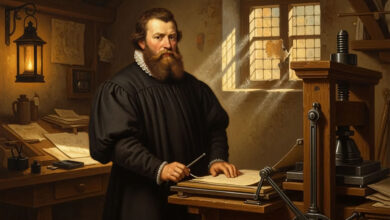James Abram Garfield, the 20th President of the United States, was born on 19 November 1831 in a small log cabin in Orange Township, Ohio, which is now Moreland Hills. He was the youngest of five children born to Abram and Eliza Ballou Garfield. His father, a hardworking farmer, died when James was just 18 months old, leaving the family in poverty. His mother worked tirelessly to support her children, instilling in them a strong sense of self-reliance and the value of education. Despite their struggles, Eliza remained determined to provide her children with opportunities to learn, fostering young James’s intellectual curiosity.
Growing up in difficult circumstances, Garfield spent much of his childhood doing farm work and other manual labour to help support his family. At the age of 16, he left home to work on the Ohio and Erie Canal, hoping to earn a living. However, after falling ill and nearly drowning, he abandoned this path and instead pursued an education. He attended the Geauga Seminary in Chester, Ohio, where he excelled in his studies despite starting with little formal education. He worked as a janitor and carpenter to pay his tuition, demonstrating an early sense of determination and resilience.
Garfield’s thirst for knowledge led him to enrol at the Western Reserve Eclectic Institute, later known as Hiram College. His dedication to his studies earned him a reputation as a brilliant scholar, and he eventually transferred to Williams College in Massachusetts. There, he continued to excel academically, particularly in classical languages and literature. He graduated in 1856 with honours and returned to Ohio to teach at the Eclectic Institute, where he quickly became a respected educator. His ability to inspire students and his passion for learning earned him the role of the college’s president at just 26 years old.
Garfield’s entry into politics was driven by his strong anti-slavery views. He joined the newly formed Republican Party and was elected to the Ohio State Senate in 1859. When the American Civil War broke out in 1861, he left politics to serve in the Union Army. He was commissioned as a lieutenant colonel and played a key role in the Battle of Middle Creek, a victory that helped secure Kentucky for the Union. His military leadership earned him rapid promotions, and by 1863, he had become a major general.
While still in the army, Garfield was elected to the U.S. House of Representatives in 1862. Encouraged by President Abraham Lincoln, he left military service to take up his congressional seat, where he served for nine terms. As a congressman, he became known for his intellect, powerful oratory, and commitment to civil rights. He supported Reconstruction policies aimed at protecting African Americans’ rights and worked to stabilise the nation’s post-war economy. His ability to navigate complex financial and legal issues made him a key figure in shaping Republican economic policies.
By 1880, Garfield had become a prominent political leader and was selected as the Republican Party’s nominee for president after a deadlocked convention. He had not actively sought the nomination but emerged as a compromise candidate. In the general election, he faced Democrat Winfield Scott Hancock and won by a narrow margin. On 4 March 1881, Garfield was inaugurated as the 20th President of the United States.
Garfield’s presidency was brief but ambitious. He advocated for civil service reform, challenging the entrenched system of political patronage. He sought to appoint officials based on merit rather than party loyalty, a stance that put him at odds with powerful political factions. His efforts to modernise the federal government and reduce corruption earned him both praise and strong opposition.
On 2 July 1881, just four months into his presidency, Garfield was shot twice by Charles J. Guiteau, a disgruntled office seeker who was angered by his failure to receive a government position. The assassination attempt took place at the Baltimore and Potomac Railroad Station in Washington, D.C. Despite surviving the initial attack, Garfield’s condition worsened due to medical incompetence and infection. He endured months of suffering as doctors probed his wounds with unsterilised instruments, exacerbating his injuries.
After weeks of fluctuating health, Garfield succumbed to complications from his wounds on 19 September 1881 at the age of 49. He died in Elberon, New Jersey, where he had been moved in hopes that the fresh seaside air would aid his recovery. His death shocked the nation, leading to widespread mourning. He was buried in Lake View Cemetery in Cleveland, Ohio.
Garfield’s presidency was one of the shortest in American history, but his legacy endured. His assassination prompted significant changes in how government jobs were awarded, leading to the eventual passage of the Pendleton Civil Service Reform Act in 1883, which introduced merit-based hiring in federal positions. His commitment to civil rights, education, and government reform reflected his deep belief in the power of knowledge and integrity in leadership. Despite his brief time in office, Garfield’s rise from poverty to the presidency remains an inspiring story of perseverance and dedication. His contributions as a scholar, soldier, legislator, and president left a lasting impact on the United States. Though his life was tragically cut short, his ideals and efforts to create a fairer and more efficient government continued to shape American politics in the years that followed.
James A. Garfield FAQ
James A. Garfield was the 20th president of the United States, serving in 1881. His presidency was tragically cut short when he was assassinated after only a few months in office.
Garfield rose from humble beginnings in Ohio, becoming a teacher, lawyer, Civil War general, and congressman before being elected president. He was known for his intellect and eloquence.
Garfield supported civil service reform, worked to curb political corruption, and sought to modernise the U.S. Navy. His stance against the patronage system put him at odds with political power brokers.
Garfield was shot by Charles J. Guiteau in July 1881. After lingering for weeks, suffering from infections made worse by poor medical treatment, he died in September 1881.




